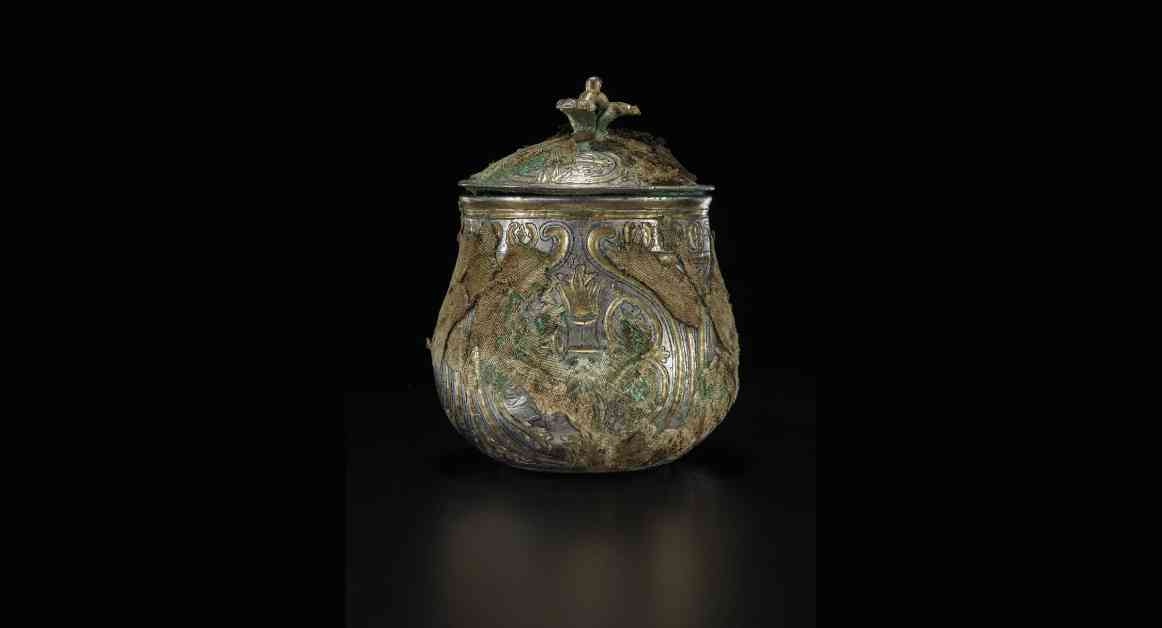Research has recently shed light on the origins of a remarkable lidded urn that is over 1,000 years old, adding a fascinating layer of intrigue to the Galloway Hoard, a collection of ancient treasures discovered a decade ago.
The Galloway Hoard, a significant archaeological find, was unearthed in 2014 near Balmaghie in the historical county of Kirkcudbrightshire. Among the treasures discovered was a lidded vessel wrapped in textiles, which were themselves considered an extremely rare survival.
Upon further examination, the lidded urn has been identified as having west Asian origins, specifically originating from what is now central Iran. The vessel, estimated to have been created around 900AD, contains intricate imagery such as crowns, fire altars, leopards, and tigers, which are considered unusual in western Europe.
Uncovering the Iran Connection
The recent discovery of the vessel’s connection to Iran has opened up a world of possibilities in understanding the cultural and trade connections of the Viking age. Dr. Martin Goldberg from National Museums Scotland expressed the significance of this finding, stating, “It’s further evidence of the cosmopolitan make-up of the Galloway Hoard. We now know that the Viking-age silver that makes up most of the hoard was melted down from coins and metalwork from early medieval England.”
The vessel’s journey from Iran to southwest Scotland is a testament to the interconnectedness of civilizations during the Viking age. Dr. Jane Kershaw, an expert on Viking-age silver from the University of Oxford, highlighted the unique composition of the vessel, noting that the silver used in its creation differs from contemporary European silver. Through scientific analysis, researchers were able to trace the origins of the silver to the Sasanian Empire in Iran.
Scientific Confirmation of Origins
The scientific confirmation of the vessel’s distant origins has provided valuable insight into the craftsmanship and trade networks of the Viking age. Elemental analysis using portable X-ray fluorescence revealed that the vessel is an alloy of silver and relatively pure copper, a characteristic typical of Sasanian silver. Additionally, isotopic analysis of the lead contained within the silver metal and niello matched ore from Iran, pinpointing the vessel’s origins to the Sasanian Empire.
The niello, a black silver-sulphide inlay that outlines the vessel’s decoration, was found to derive from the famous mine of Nakhlak in central Iran. This level of detail in tracing the materials used in the vessel showcases the meticulous craftsmanship and the long-distance trade routes that connected distant lands during the Viking age.
Display and Exhibition
The lidded urn, along with other objects from the Galloway Hoard, will be displayed for the first time at the British Museum’s forthcoming exhibition, Silk Roads, in London. This exhibition will provide visitors with a unique opportunity to witness the cultural exchange and artistic influences that shaped the Viking age.
Dr. Sue Brunning from the British Museum emphasized the significance of the Galloway vessel, stating, “For the first time it will be displayed alongside a similar vessel found in northern Britain and also used as a Viking-age treasure container, but the Galloway vessel is the only one confirmed as originating beyond Europe, in lands far to the east.”
The inclusion of the Galloway vessel in the Silk Roads exhibition highlights the interconnected nature of ancient trade routes and the diverse cultural influences that shaped the Viking age. Visitors to the exhibition will have the opportunity to explore the rich history and intricate craftsmanship of the Galloway Hoard, shedding light on the global connections that existed in the ancient world.
In conclusion, the discovery of the lidded urn’s Iran connection in the Galloway Hoard provides a fascinating glimpse into the cultural exchange and trade networks of the Viking age. The vessel’s origins in central Iran and its intricate craftsmanship underscore the cosmopolitan nature of the Viking age and the interconnectedness of civilizations across vast distances. As the vessel goes on display for the first time, it offers a unique opportunity to appreciate the artistry and complexity of ancient artifacts, while also sparking new avenues of research into the historical significance of the Galloway Hoard.
































